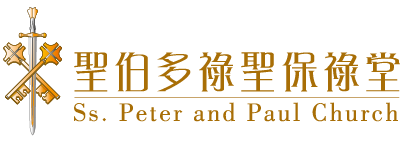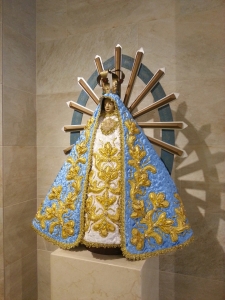 Our Lady of Lujan
Our Lady of Lujan
Devotion to Our Lady of Luján began in 1630, when a farmer, named Farias, who had emigrated from Portugal to Argentina decided to build a chapel on his lands. He wrote to a friend in Brazil asking him to send a small statue of the Virgin Mary for his chapel. The friend sent two statues from Brazil, one statue represented Mary under the advocation of the Mother of God, and the other, the Immaculate Conception. First transported by sea, the statues were then placed on a cart pulled by oxen for the rest of the journey on land. The travelers stopped at the Luján River to stay the night at the house of Rosendo. The next day, wanting to continue their journey, the oxen would not move the cart. Thinking that the cart was too heavy, the travelers unloaded cargo, but in vain, the oxen would not move. They took off both images of the Virgin Mary to no avail. Finally, after many attempts, the travelers unloaded the box with the image of Our Lady of Luján – leaving on the cart the image of the Mother of God – and to everyone’s amazement the oxen proceeded on their journey. Thus, the Immaculate Conception remained, as the Woman who waits.
The statue was enthroned in a small chapel, where Mary had chosen to remain. This is the image of Our Lady of Luján, which became the most venerated image in all the region. In 1671 the statue was relocated to the property of Ana de Matos, where a larger chapel was built in Her honor. As other miracles were attributed to her intercession, the pilgrims began to come to pray in ever greater numbers. In 1677 her image was kept in a church built in her honor, until a larger one replaced it in 1763. She was crowned and given the official title “Our Lady of Luján” on May 8, 1887; which is now her feast day. Work on a large Basilica reached its completion in 1904 and the image of Our Lady of Luján was solemnly transferred there. And this is where she remains, waiting, awaiting the visits of thousands of pilgrims each year to their loving and tender Mother.
On September 8, 1930, three hundred years since the miracle of Luján, Pope Pius XI named Our Lady of Luján Patroness of Argentina, Uruguay and Paraguay. The image of Our Lady of Luján – who is enrobed in an ornate blue and white dress and crowned as Queen – is now enthroned in the Basilica in Buenos Aires.Since 1630, Our Lady of Luján has patiently awaited and watched over her many children with a special maternal gaze. We also firmly believe that she awaited us, the Religious Family of the Incarnate Word, for our foundation in 1984. Fr. Carlos Buela, our Founder, would often pilgrimage to her shrine as a seminarian in order to beg her for holy priestly and religious vocations. We call her the Mother of our Vocations, and believe that she is truly the loving Mother who graciously calls and guides each one of us to Our Religious Family. Taking our spirituality of St Louis Marie Grignion de Montfort and St John Paul II, we must go ‘to Jesus through Mary,’ because Mary always leads to Christ. It is under this name, Our Lady of Luján, that the Religious Family of the Incarnate Word lovingly invokes Mary as our Patroness.
Declared official Patroness of the missionaries of the Religious Family of the Incarnate Word in 2012, Our Lady of Luján continues to journey to foreign lands (in our parishes and convents she now awaits her children in 48 countries!), attracting the hearts of all men to accompany her at the foot of the Cross, the instrument of Redemption and sign of evangelization.
The image of Our Lady of Luján, along with the image of the Sacred Heart of Jesus, is on the scapular of the Religious Family of the Incarnate Word which was received by all her members on September 8th 2020. We wear it proudly, receiving her continual protection and reminding ourselves of our two greatest loves – Jesus Christ and His Mother. They are our ideal, the object of our thoughts, the end of all of works, labors, and struggles in this life. If you ask any member of the Religious Family of the Incarnate Word, “Who is your Mother?” they will immediately reply, “Luján.”
The Mystery of the Woman who waits. It is the mystery of Our Mother who has awaited us, is awaiting us, and will await for the moment we can be united with Her and Her Son in Heaven. It’s no coincidence that the word in Spanish for wait, ‘espera’, can also mean to hope. May Our Lady of Luján, The Woman who awaits us, be the first to receive us when we enter our heavenly homeland.
Resources
Buela, Rev. Carlos M. (2011). Maria de Lujan, el misterio de la mujer que espera. New York: IVE Press.
Galeria. (2021). Retrieved from Instituto de Estudios Lujanenses: https://virgendelujan.org/galeria/
Schedule of Eucharistic Adoration
Overnight Eucharistic Adoration
Every first Friday and third Saturday of the month
Hour of Mercy
Every day at 3:00pm in the Chapel

 Our Lady of Lujan
Our Lady of Lujan